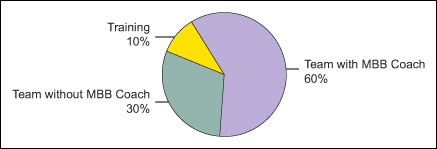
Often, new team members are introduced to Lean Six Sigma using the following model:
- One week of training
- One month of project work led by a Black Belt or Green Belt
- Individual coaching scheduled at regular intervals during project work
A priority courier express company experimented with this model in order to increase the likelihood of success of its Lean Six Sigma initiative. The approach the company used accelerated adoption of the methodology and helped the team deliver positive results. In addition, the methods triggered creativity and leadership beyond the original project.
Critical Differences in Deployment
A small team at the courier company was focused on a project to increase customer and employee satisfaction, to reduce cost, and to increase capacity, with benefits delivered within four months. Instead of following the traditional route, the team’s Lean Six Sigma model included the following innovations:
- Training was integrated with project execution, rather than preceding it
- Starting at Day 1, Lean Six Sigma concepts were applied; there was no revving up to start
- Ongoing, real-time coaching was provided by a Master Black Belt who was a member of the team
Team member time allocation for this plan is shown in the figure below.

Tactics for Integrated Training
Higher success rates and new leadership skills are the goals of any Lean Six Sigma initiative. Two tactics used in this scenario can be pivotal parts of training and enable higher project success rates:
- A realistic simulation aligned with the team’s own business experience
- A road map to center participants on a common process for project execution
In this case, the simulation provided hands-on experience related directly to the company’s business processes, and demonstrated relevance to the team’s business experience, all while linking Lean Six Sigma concepts to the project at hand.
Using Real-time Coaching
In coaching to develop Lean Six Sigma and leadership skills, the traditional approach is individual, private sessions. Individuals learn concepts first and then demonstrate application of the concepts in the coaching sessions.
The priority courier express company used real-time coaching instead. Key characteristics of this model:
- Coaching is integrated with project execution in a team setting
- The coach is a team member and a Master Black Belt
- All members are developed simultaneously and equally invested in the effort
The result is that each team member becomes a well-rounded practitioner by the end of the four-month project period and is prepared to lead project teams independently going forward.
Getting Innovative
Greater success in Lean Six Sigma can be enabled by innovations in deployment, training and coaching. Companies can look for benefits like these achieved by the priority express courier company:
- The team-driven approach resulted in enthusiasm, application competency and superior project results.
- Master Black Belt coaching integrated with project execution drove faster development and independence of team members.
- Results achieved by hands-on training experience (simulation) were magnified by the dedicated team approach.
- Team members were empowered by the success of the team-driven approach and integrated coaching to initiate and lead new projects, carrying forward the innovations they experienced.